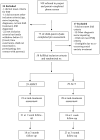Attention Bias Modification Treatment for Adolescents With Social Anxiety Disorder
- PMID: 30661553
- PMCID: PMC6347411
- DOI: 10.1016/j.beth.2018.04.002
Attention Bias Modification Treatment for Adolescents With Social Anxiety Disorder
Abstract
Social anxiety disorder (SAD) tends to emerge during the early teenage years and is particularly refractory to change even when standard evidence-based CBT treatments are delivered. Efforts have been made to develop novel, mechanistic-driven interventions for this disorder. In the present study, we examined Attention Bias Modification Treatment (ABMT) for youth with SAD. Participants were 58 adolescents (mean age = 14.29 years) who met diagnostic criteria for SAD and who were randomized to ABMT or a placebo control condition, Attention Control Training (ACT). We predicted that ABMT would result in greater changes in both threat biases and social anxiety symptoms. We also explored potential moderators of change including the severity of social anxiety symptoms, the level of threat bias at pretreatment, and the degree of temperament-defined attention control. Contrary to our hypotheses, changes in attention bias were not observed in either condition, changes in social anxiety symptoms and diagnosis were small, and significant differences were not observed between the ABMT and ACT conditions. Little support for the proposed moderators was obtained. Reasons for our failure to find support for ABMT and its potential moderators are explored and recommendations for changes in the ABMT paradigm are suggested.
Keywords: adolescents; attention bias modification training; dot probe; social anxiety disorder.
Copyright © 2018. Published by Elsevier Ltd.
Figures
References
-
- American Psychiatric Association. Diagnostic and statistical manual of mental disorders. 5. Washington, DC: Author; 2013.
-
- Amir N, Najmi S, Bomyea J, Burns M. Disgust and anger in social anxiety. International Journal of Cognitive Therapy. 2010;3:3–10. doi: 10.1521/ijct.2010.3.1.3. - DOI
Publication types
MeSH terms
Grants and funding
LinkOut - more resources
Full Text Sources
Medical
Miscellaneous



